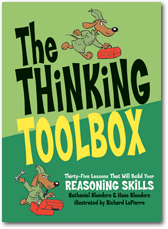The Thinking Toolbox: Thirty-Five Lessons That Will Build Your Reasoning Skills is another delightful offering from brothers Nathaniel and Hans Bluedorn. Recommended for ages 12 and up, it picks up where their book The Fallacy Detective (now in its third printing) left off, and helps readers to delve more deeply into informal logic. Their unique books fill a need in the homeschooling world -– reminding us that acquiring knowledge is a worthy goal, but that we also need the tools to responsibly wield that knowledge.
The Thinking Toolbox is laid out similiarly to the Bluedorns’ previous book, with short chapters, humorous illustrations, and end-of-chapter exercises to apply what we’ve just learned (I say “we”, because this is definitely a book you’ll want to read and discuss with your teens!). The tone and humor help to lighten what can be a weighty subject.
The first section, “Tools for Thinking,” discusses inferences, fact, and opinion — listing reasons why you believe something, premises and conclusions, and much more. Favorite parts for our family are the sections on defeating your own argument so you can anticipate others’ arguments, and the differences between a discussion, disagreement, argument, and fight (maybe some of today’s politicians should take note?). As a parent, my favorite chapter is the one entitled, “When It Is Dumb to Argue”! Thank you, Bluedorn brothers! In all seriousness, they shed light on when it is futile to engage in an argument, and times it is best to keep silent, a wonderful application of Proverbs 26:4, “Do not answer a fool according to his folly, lest you also be like him.”
Section two, “Tools for Opposing Viewpoints,” guides us through logical thinking and decision making, using tools such as making an “opposing viewpoints” chart, considering all the evidence, and learning about primary and secondary sources. I love how the Bluedorns break issues down in such a practical manner, encouraging teens to consider issues objectively, and reminding them to make difficult decisions logically and with as little emotional bias as possible. If this sounds boring, let me assure you that their clever writing and humor make all of the information approachable. Also, I have to admit, their example “opposing viewpoints” chart about Charles Dickens was so hilarious that I read it out loud to my husband!
The third section, “Tools for Science,” shows us how good thinking and the scientific method go together, with illustrations such as brainstorming, coming up with useful hypotheses, testing predictions, and researching. A favorite chapter of ours in this section is “Pseudoscience,” which illustrates how some of what is presented as science these days is most definitely not. In a world of moral relativism, these are invaluable tools for our teens.
“Projects and Games,” included at the end of The Thinking Toolbox, encourages students to use what they’ve learned, giving ideas for project fairs or competitions, suggesting games for use in a group, or solving a mystery in the last chapter (thankfully, answers provided!). These are great applications for all we’ve just learned.
Like The Fallacy Detective, The Thinking Toolbox is one of my recommendations and absolute favorite books for high school. The Bluedorns have again managed to craft a unique book, one which is perfect for the homeschooling setting. As the mother of two college students, I know that the area of thinking skills and logic is vitally important to cover with our children before they graduate. The Thinking Toolbox makes that job just a little bit easier!
Jen McDonald


0 Comments